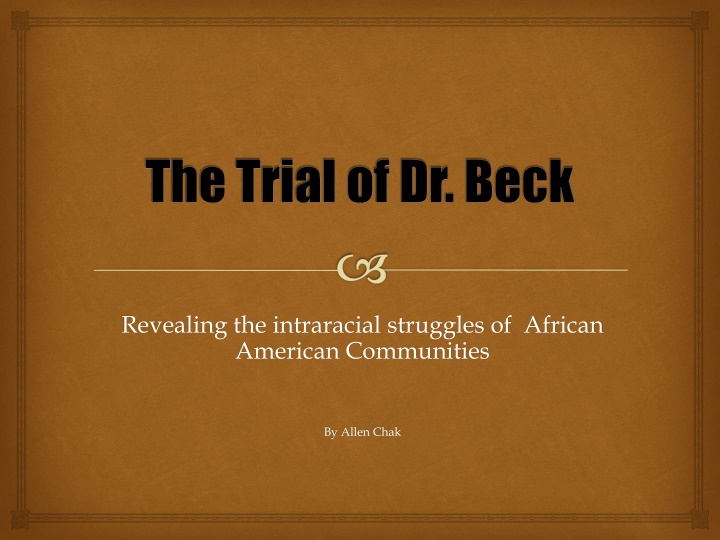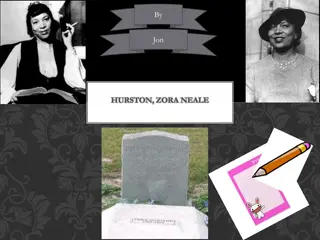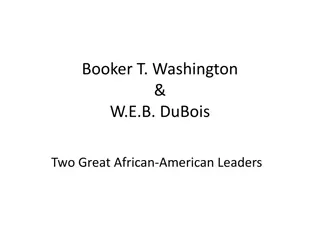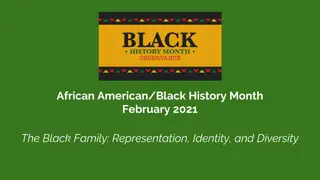Intraracial Struggles in African American Communities: The Trial of Dr. Beck
Delve into the exploration of intraracial struggles within African American communities revealed in "The Trial of Dr. Beck." The play by Hughes Allison sheds light on discrimination based on skin color and social status among African Americans in the 1930s. This narrative uncovers the impact of societal perceptions on success and self-expression, challenging prevalent biases and paving the way for cultural and social transitions.
Download Presentation

Please find below an Image/Link to download the presentation.
The content on the website is provided AS IS for your information and personal use only. It may not be sold, licensed, or shared on other websites without obtaining consent from the author.If you encounter any issues during the download, it is possible that the publisher has removed the file from their server.
You are allowed to download the files provided on this website for personal or commercial use, subject to the condition that they are used lawfully. All files are the property of their respective owners.
The content on the website is provided AS IS for your information and personal use only. It may not be sold, licensed, or shared on other websites without obtaining consent from the author.
E N D
Presentation Transcript
The Trial of Dr. Beck Revealing the intraracial struggles of African American Communities By Allen Chak
Introduction The Trial of Dr. Beck, by Hughes Allison, is a 1930 s melodrama written for production on the Federal Theater Stage. It was one of the first plays to explore the idea of intraracial struggles in the 1930 s. Hughes Allison analyzed and revealed the internal discrimination within the African American communities caused by skin color and social and financial standing. Because of the controversial yet relevant topics in the play, it became a theatrical success on Broadway. During the Jim Crow era, many African Americans believed that being more White determined their social and economical standing over others. However in the 1930s the Harlem Renaissance dispelled many of these fallacies. The movement granted pioneers such as Duke Ellington and Langston Hughes freedom to create aspects of the African American culture. The effects of the renaissance paved the way for African Americans to develop their own social and artistic ideas without the shackles of western culture and prejudice. This exhibit will include artifacts and photos from the Rose Library and the The Camille Billops and James V. Hatch Archives. Using these resources, this exhibit will illustrate the cultural and social transitions of African American Culture before and after the Harlem Renaissance.
How Looks Defined a Person Harper's Weekly Scientific Racism 1899 Still Image Frederick Ludwig Hoffman Negroid Sane Criminals and Negroid Civil Insane 1968 Still Image This drawing shows the head shape of a Negro to that of Europeans and Irishmen. We can see that the drawing depicts Negro s as less developed and an inferior race when compared to Anglo-Teutonics. The Irish is also drawn to be less developed as many slaves were also Irish. Laws and books published on how skin color and looks define a person s worth created the belief that being more white results in success. This crutch prevented African Americans from expressing themselves as many believed the white way was the right way. This is a picture from the book Race Traits and Tendencies of the American Negro. The book contains studies on Eugenics, the science of creating a better human, which contributed to the way African Americans were treated. The book contains studies and pictures of how the Negro race was less developed than their European white counterparts. This Eugenics movement was a catalyst for segregation laws and the belief that African Americans were scientifically the inferior race. This belief also caused the state to sterilize people with less desired traits which oppressed many generations of both European and African Americans.
Anonymous An Old West courtroom : including judge, jury, lawyers and observers No Date Still Image This is a picture of an old West courtroom. We can see that the entire jury panel is white as well as the lawyers and the judge. However, the defendant is the only African American in this trial. The jury, which is the most powerful group of people in the room are all dressed nicely in tuxedos. They are also all white, relating the symbol of power and control to being white. Due to laws and policies, African Americans were not allowed to be in positions of power.
Anonymous Woman with earrings lying in cloth with hair spread up No Date Still Image The lady in this image is lying on a bed to straighten her hair out. African Americans are thought to have curly hair and European Americans mostly had straight hair. This means many African Americans used hair products such as hair straightener to look more White . In the play, The Trial of Dr. Beck, Dr. Beck s white was a successful business women who found her success through the invention of hair straightness. This shows that in order to become successful and rich, one has to look more White .
Anonymous African American holding Panama hats, posing on a sidewalk No Date Still Image This is a picture of a group of African Americans in the dressed in suits and nice clothing. The bow tie shows that they are not businessmen but more in line with attendees at a dinner party. Along with nice clothing, a few of the men are smoking cigars which is a symbol of the upper class or people with power. This symbol of wealth and upper class was not common for African Americans at this time. The upper class relates to Hughes Allison s The Trial of Dr. Beck as the one of the play s main focus is on the social hierarchy of the African American community.
The Trial of Dr. Beck Hughes Allison The Trial of Dr. Beck 1937 Play Script The Trial of Dr. Beck is a thin leather bound book from the 1930 s. This artefact belonged to one of the actors who performed in the Broadway run of the play. The play s main focus is on the belief that skin color and looking more white determines one s economical and social success. This mentally was a microcosm of the larger external racism African Americans endured. In the play Dr. Beck, a handsome olive skinned man, is being accused of murdering his wife. The evidence provided was that Dr. Beck detested people with dark skin as he believed having lighter skin was more attracted and determined a person s success. The main goal of the author was to reveal this extremely important issue to the African Community and urge them disregard this way of thinking. This was extremely important during the Harlem Renaissance as the movement was about developing group culture and art for African Americans. The movement was about breaking free from White moral values that reinforced racist beliefs.
Hughes Allison The Trial of Dr. Beck 1937 Play Script This is a list of the Characters from the play as well as Physical and Racial Characterises of each person to help the casting crew find actors. We can see that the white and negro actors are separated . The negro actors also have more descriptions and characteristics than the white actors. The color of the skin is the most details as the difference in skin color is one of the major themes in the play. Beck s skin color is described as the only Olive skin in the cast. He is also the most handsome character in the play. This is an important fact as many believed that the lighter skin a person had, the more attractive they are. The separation of races could symbolize the fact that African Americans are being more individualized from European culture. African Americans as a whole have developed a sense of identity through creating art and culture.
The Harlem Renaissance In the background of this photo is the Apollo theater. It was one of the first theaters in Harlem to open its doors for African American performers. The Apollo is known as the starting point of many African American artists during the Harlem Renaissance. Standing in front of the Apollo is Duke Ellington, one of the pioneers of Jazz music. Jazz music was one of the art forms that separated African Americans from European Americans. Jazz was a mix of African rhythms and European harmonies, which symbolized the equally of Blacks and Whites. Richard Avedon Duke Ellington in front of the Apollo Theatre 1963 Still Image
Anonymous Portrait of African American poet Langston Hughes 1955 Still Image Langston Hughes was one of if not the most important poet and artist of the Harlem Renaissance. His essay, The Negro Artist and the Racial Mountain, published in The Nation magazine became the manifesto of the Harlem Renaissance. His most important message was for Black artists to be themselves, free from the shackles of white culture. We younger Negro artists who create now intend to express our individual dark-skinned selves without fear or shame. If white people are pleased we are glad. If they are not, it doesn't matter. Langston Hughes Langston Hughes The Negro Artist and the Racial Mountain 1926 Essay
Conclusion The exhibit began by showing the different cases of racial discrimination and racism during the early 20th century. We see that eugenics, which was the belief of improving the human species with reproduction and sterilization, was the beginning of systematic racism that prevented many African Americans from independent thought. This movement brought in the notion that being white resulted in a person being more successful and attractive. African Americans changed they way that they acted and looked to seem more white. However, the Harlem Renaissance created places such as the Apollo Theater which became a safe haven for African American culture and artistic expression. By becoming and forming a group identity, African Americans rejected the fact that they were an inferior race. Play wrights like Hughes Allison and Langston Hughes urged the African American community to disregard such racist beliefs like Eugenics. They became the catalysts for individualism that freed the African American community from white values and beliefs.























